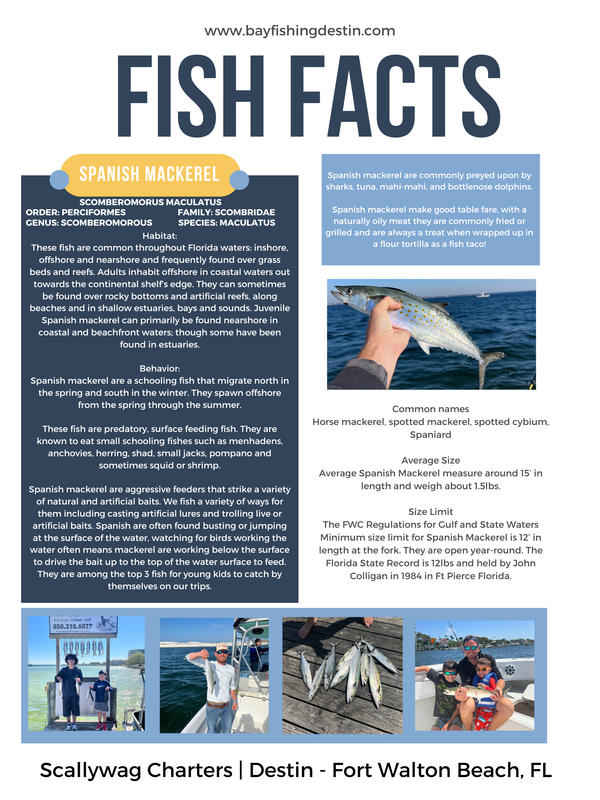|
Spanish Mackerel - Scomberomorus maculatus
Order: Perciformes Family: Scombridae Genus: Scomberomorous Species: maculatus Common names Horse mackerel, spotted mackerel, spotted cybium, Spaniard Average Size Average Spanish Mackerel measure around 15’ in length and weigh about 1.5lbs. Size Limit The FWC Regulations for Gulf and State Waters Minimum size limit for Spanish Mackerel is 12’ in length at the fork. They are open year-round. The Florida State Record is 12lbs and held by John Colligan in 1984 in Ft Pierce Florida. Habitat: These fish are common throughout Florida waters: inshore, offshore and nearshore and frequently found over grass beds and reefs. Adults inhabit offshore in coastal waters out towards the continental shelf’s edge. They can sometimes be found over rocky bottoms and artificial reefs, along beaches and in shallow estuaries, bays and sounds. Juvenile Spanish mackerel can primarily be found nearshore in coastal and beachfront waters; though some have been found in estuaries. Behavior: Spanish mackerel are a schooling fish that migrate north in the spring and south in the winter. They spawn offshore from the spring through the summer. These fish are predatory, surface feeding fish. They are known to eat small schooling fishes such as menhadens, anchovies, herring, shad, small jacks, pompano and sometimes squid or shrimp. Spanish mackerel are aggressive feeders that strike a variety of natural and artificial baits. We fish a variety of ways for them including casting artificial lures and trolling live or artificial baits. Spanish are often found busting or jumping at the surface of the water, watching for birds working the water often means mackerel are working below the surface to drive the bait up to the top of the water surface to feed. They are among the top 3 fish for young kids to catch by themselves on our trips. About Spanish Mackerel are epipelagic. The Epipelagic Zone is also known as “The Sunlight Zone”. This is the uppermost layer of the ocean or gulf, ranging from 33-115 feet Most of the fish humans consume are found in the epipelagic zone. Spanish Mackerel frequent barrier islands and passes associated with these islands. Larvae occur mostly offshore, while juvenile mackerels are found offshore and nearshore along the surf at the beach. The population of Spanish mackerel in the Gulf of Mexico are known to migrate westwards in the early spring to waters off Texas. They can be found migrating along the coast of Mexico heading south between the months of August – November and heading north towards Florida in March and April. Spanish mackerel are silver along the surface of the body with iridescent blue-green with a few rows of large dark elliptical yellowish spots along the sides of its body. The longer the fish, the more spots it tends to have. They have large jaws and teeth that are triangular and arranged in a single series. Spanish mackerel have separate male and female sexes that use external fertilization. Spawning is said to take place between April and October depending on the location of the fish at the time. Along the inner continental shelf of Texas, spawning occurs May – September. In the waters off of Florida’s east coast they spawn July – September. In the northern portion of the gulf off the Florida panhandle, spawning is said to take place August – September. Eggs are buoyant, transparent, and round in shape. Hatching typically occurs within 25 hours at 79°F. Both males and females mature by 2 years of age. At this time males are usually around 8 inches in length while females are around 11 inches. Spawning is said to occur at night over the inner and mid-continental shelf. Spanish mackerel are commonly preyed upon by sharks, tuna, mahi-mahi, and bottlenose dolphins. Spanish mackerel make good table fare, with a naturally oily meat they are commonly fried or grilled and are always a treat when wrapped up in a flour tortilla as a fish taco! Sources : https://myfwc.com/fishing/saltwater/recreational/spanish-mackerel/ https://www.dnr.sc.gov/marine/species/spanishmackerel.html https://www.floridamuseum.ufl.edu/search/?q=spanish+mackerel
0 Comments
Leave a Reply. |
Welcome to Scallywag Charters Blog!
Recipes |

